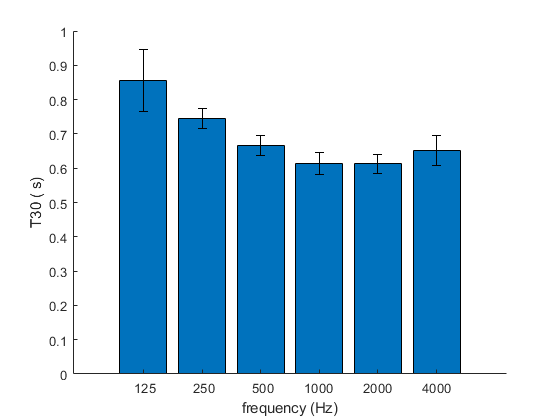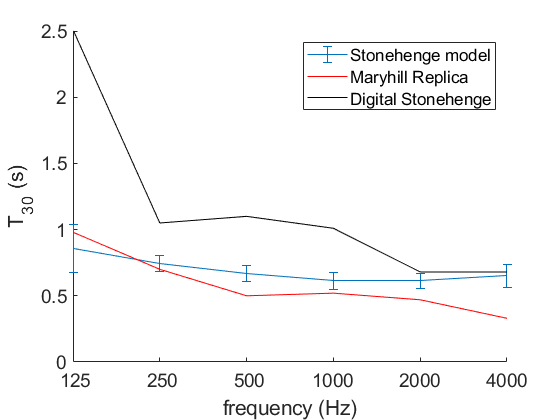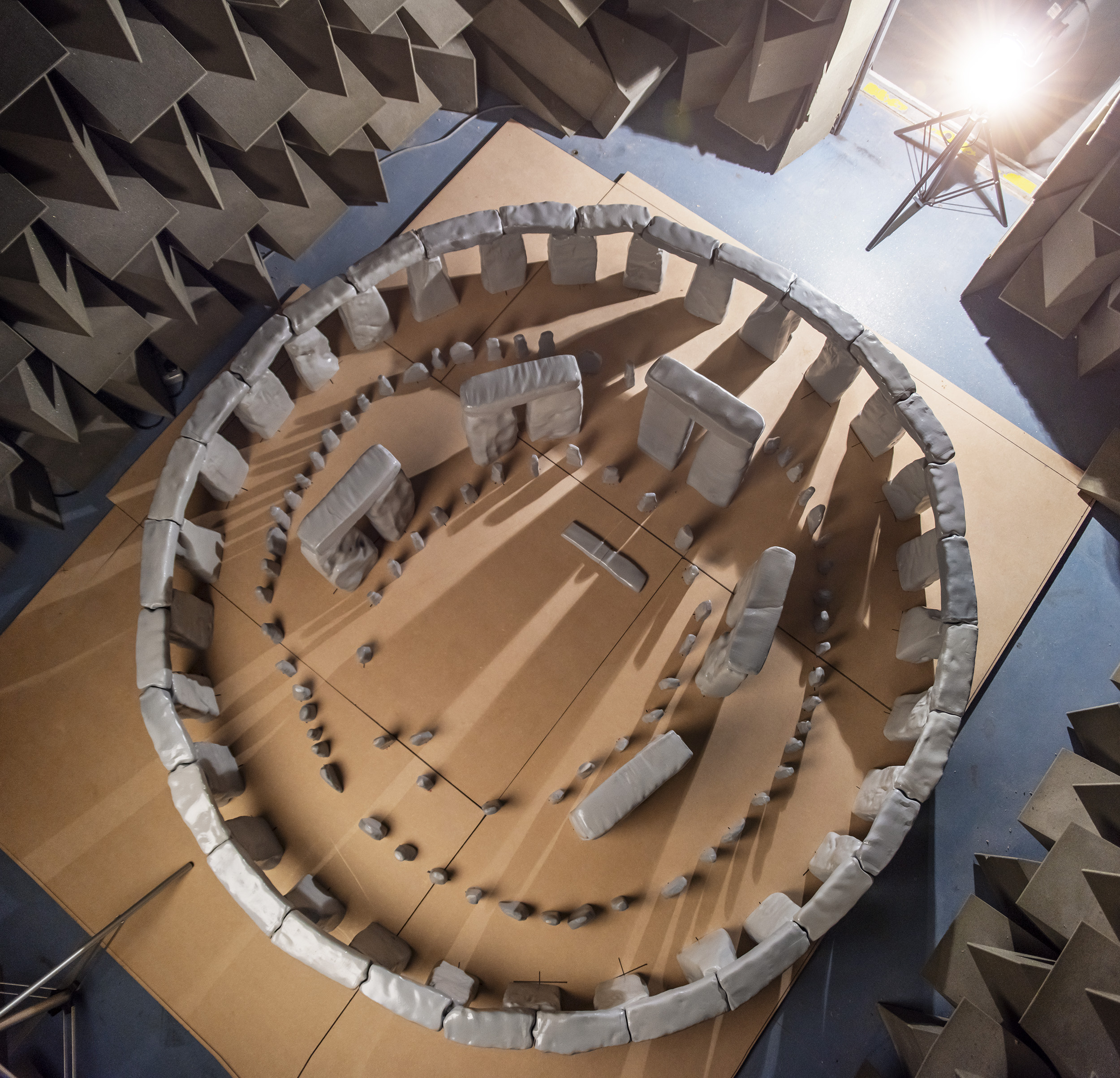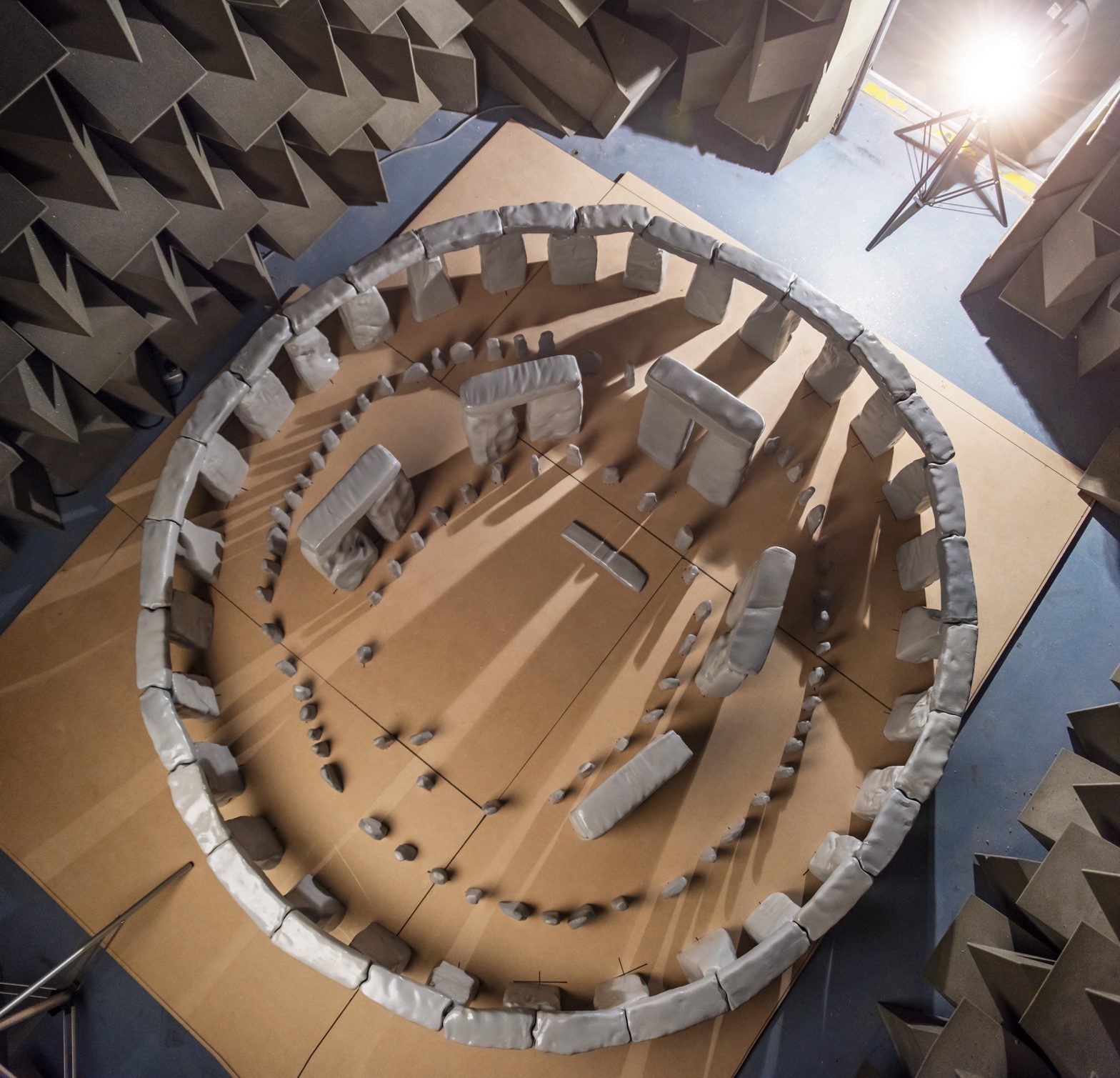Update: These results have now been published in the Journal of Archaeological Science.
Reverberation is a key characteristic of a room. When an orchestra stops playing, the music lingers a short while as the sound bounces around the room gradually dying away. This reverberation help amplify the orchestra, creating a richer and more engaging sound. For speech, if the reverberation is moderate, the amplification aids communication. Reverberation is so important to music that it is even added to electronic pop music recorded in studios. Some have compared reverberation to tomato ketchup; something that when added makes most things sound (or taste) better.
We don’t know what music or speech might have featured within Stonehenge thousands of years ago. But given that most human ceremonies involve talking and music, it seems reasonable to assume that sound was important within Stonehenge. And if sound is important, than so is the reverberation.
My 1:12 Acoustic Scale Model of Stonehenge allows us to examine the acoustic within the stones in the 2200 BC configuration. My last blog outlined how the measurements were made, here I start examining the reverberation results.

The most popular way of quantifying the amount of reverberation is via the reverberation time. This is the time it takes sound to decay by 60 dB. In a living room it is about 0.4 seconds, in a large orchestral venue 2 seconds and a large cathedral maybe 8 seconds. What is the reverberation time in Stonehenge?
Fig. 2 shows the reverberation time averaged over thirty source and receiver positions. The first surprise is it has reverberation! If you look at the picture of the model (Fig. 1), there are lots of gaps between the stones and there is no ceiling. So you might expect the sound to decay very rapidly as it disappears out of the henge. But evidently there are enough stones to keep the sound bouncing back and forth roughly horizontally. The reverberation time is about 0.6 seconds at mid-frequency.

For comparison, Fig. 3 is a classic chart showing typical reverberation times as a function of room volume and type. In terms of reverberation, Stonehenge is most like a TV studio, it has a relatively low reverberation time considering the size of the space. (The volume of Stonehenge is ill-defined, but if it is taken to be the same as a cylinder that fits inside the outer sarsens, then it is 3,300 m3).

Maryhill and current Stonehenge
My colleagues Bruno Fazenda and Ian Drumm published some reverberation times measured in the current configuration of Stonehenge and also a concrete replica in Maryhill, USA [1]. In Fig. 4 a comparison of the reverberation times is shown.
The reverberation time of the current Stonehenge is very low, at around 0.3 seconds. This is to be expected because many of the stones are either missing or fallen over. Having recently been to the site, I can say that the reverberance I heard was barely audible, as these results suggest.

The comparison to the Maryhill replica is more interesting, because the stone configuration is quite similar to the 1:12 scale model [2]. But there are differences between the reverberation times. At mid-frequency, the reverberation time in Maryhill is about 0.5 seconds, whereas it’s 0.64 seconds in the 1:12 scale model. This difference is relatively small, but would be audible [3].
Looking at pictures of Maryhill (e.g. Fig. 5), compared to the 1:12 scale model, the most obvious difference are the number of bluestones. Also the Maryhill replica is much more regular. In contrast, the 1:12 scale model is made up from much more amorphous shapes, as you might expect from worked stone. This will alter how sound will bend around and reflect from the stones. The sound wavelength ranges from about 4 m to 6 cm for the frequency range we’re most interested in. The stones have dimensions and roughness that are similar in size. Consequently, diffraction effects are very important to the behaviour of sound in Stonehenge. It isn’t surprising that the reverberation times don’t exactly match between Maryhill and the scale model. Indeed, knowing that the Maryhill replica was too regular was one of the motivations behind making the acoustic scale model.
Another possibility for the difference might be the materials. Maryhill is made from concrete, and the absorption of that varies with how porous it is. The acoustic scale model was made to have low absorption to try and match the properties of the real bluestones and sarsens at Stonehenge. Another source of uncertainty is the absorption of the ground.

Digital Stonehenge
Fig. 6 shows the reverberation time from Maryhill and the scale model with the addition of a prediction by Till using a geometric room acoustic model (‘Digital Stonehenge’) [4]. It is clear that the Digital Stonehenge model is inaccurate and not producing reliable results except for the highest two octave bands.

Digital Stonehenge uses a popular piece of commercial software that uses geometric modelling. But such models struggle to predict the pressure and extent of focusses from concave surfaces (like the circle of outer sarsens) [5,6]. Furthermore, geometric models are only physically correct when the wavelength of sound is small compared to surface dimensions. As noted above, this is certainly not the case in Stonehenge. A round robin of such models found that the biggest errors with the predictions were consistently at low frequencies, because geometric methods can not properly simulate diffraction and interference effects [7].
Although the commercial model includes empirical fixes to deal with some of the issues, the application of a geometric model to Stonehenge shouldn’t be done without a proper process of validation to demonstrate that the modelling is producing accurate results.
Next I’ll look at early decay time (EDT), that is known to relate more closely to the perceived reverberance.

Notes and References
[1] Fazenda, B. and Drumm, I., 2013. Recreating the sound of Stonehenge. Acta Acustica united with Acustica, 99(1), pp.110-117.
[2] The number of bluestones is different.
| Maryhill | 1:12 scale model | |
| Inner bluestones | 15 | 24 |
| Outerbluestones | 30 | 57 |
[3] The smallest perceivable change in these short reverberation times is about 0.04 seconds, see Niaounakis, T.I. and Davies, W.J., 2002. Perception of reverberation time in small listening rooms. Journal of the Audio Engineering Society, 50(5), pp.343-350.
[4] Till, R., 2009. Songs of the stones: the acoustics of Stonehenge. The sounds of Stonehenge, pp.17-39.
[5] M. Vercammen, “Sound reflections from concave spherical surfaces. Part II: Geometrical acoustics and engineering approach”, Acta Acust. uw Acust., 96(1), 92–101 (2010).
[6] M. Vercammen, “Sound reflections from concave spherical surfaces. Part I: Wave field approximation”, Acta Acust. uw Acust., 96(1), 82–91 (2010).
[7] I. Bork, “A comparison of room simulation software – the 2nd round robin on room acoustical computer simulation”, Acustica, 86, 943–56 (2000).
Follow me
7 responses to “How reverberant was Stonehenge?”
Hi,
I thought this was a very interesting piece. Have you modelled the wider environment, such as the ground conditions/type of vegetation and local topography, to see what effect these will also have on the soundscape?
We’re mostly looking inside the stone circles where the outside topology will not make a difference. We did measure some inside-outside positions, but only to places close to the sarsens.
Super! Just listened to the Lost Voices of Hagia Sophia by Cappella Romana, recorded in a studio and then with the acoustics added – what a wonderful expansion of sound. No wonder we love music in cathedrals.
So interested but I know nothing. However have often wondered about this subject having heard drumming from inside the Henge and thought the sound reverberated off the stones.
Yes in the current Stonehenge there are some subtle echoes that you can hear with hand claps.
And what happens when the space is full of people?
Really good question. Hoping to do some measurements on that this academic year. The reverberation time would reduce.